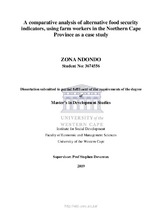| dc.contributor.advisor | Stephen Devereux | |
| dc.contributor.author | Ndondo, Zona | |
| dc.contributor.author | Devereux, Stephen | |
| dc.date.accessioned | 2020-02-24T10:31:01Z | |
| dc.date.available | 2020-02-24T10:31:01Z | |
| dc.date.issued | 2019 | |
| dc.identifier.uri | http://hdl.handle.net/11394/7152 | |
| dc.description | Magister Artium (Development Studies) - MA(DVS) | en_US |
| dc.description.abstract | The concept of food insecurity is complex and difficult to measure. Food insecurity is measured
at different levels – global, national, household and individual. In order to have appropriate
assessments of food security status, it is important to use the correct measure. This study focused
on explaining three major indicators of household food security in measuring the different
dimensions of food security (availability, access, utilization and stability). The contribution of this
study is to add to the literature and determine how appropriately different indicators measure food
security.
The study explored the relationship between the three alternative indicators of food security by
comparing them, using data collected on farm workers in the Northern Cape Province of South
Africa. From the results of the study, it was concluded that most of the surveyed farm workers in
the Northern Cape Province are food insecure. This conclusion was arrived at because of two
indicators. The Household Food Insecurity Access Scale (HFIAS) reported 42.8% of farm workers
as severely food insecure; 42.8% as moderately food insecure; and 13.9% as mildly food insecure.
The Coping Strategies Index (CSI) reported 56.2% of farm workers as food insecure. The Dietary
Diversity Score (HDDS) reported a higher dietary diversity in farm workers (71.8%). | en_US |
| dc.language.iso | en | en_US |
| dc.publisher | University of the Western Cape | en_US |
| dc.subject | Food insecurity | en_US |
| dc.subject | Food security | en_US |
| dc.subject | Indicators | en_US |
| dc.subject | Households | en_US |
| dc.subject | Coping strategies | en_US |
| dc.title | A comparative analysis of alternative food security indicators, using farm workers in the Northern Cape Province as a case study | en_US |
| dc.rights.holder | University of the Western Cape | en_US |

